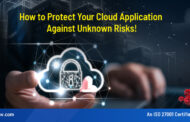With the yuletide season around the corner, a lot of organizations allow the flexibility to work from home to their employees. By default communicating via mobile phones and computer become a norm, data security becomes more of a concern. Right from the employees making use of an insecure WIFI connection, to the employees carrying physical copies of confidential information along with them, given these facts, remote work has added additional levels of security considerations for companies and their data. In such a scenario, leaders from every organization and their employees need to accept equal accountability in doing what they can to protect their organization’s data.
Leaders should take the onus on implementing a program of educating their employees about data security and how everyone is responsible for protecting it. Certain practices and procedures should also be put in place that would strengthen the data security within their business. Strong rules should be implemented for those who chose to work remotely asking them to prioritize data security education and safe practices.
So what can organizations and their employees who work remotely do to protect their data?
- Constructing a strong Cybersecurity policy
Every organization has a set of employees who are unaware that data security is something they should be concerned about both at a personal and professional level. At the same time, organizations cannot assume that their employees know anything about cybersecurity or the role it plays in data protection. Hence, the best place to begin is implementing a cybersecurity strategy, which would require all the existing employees to review and sign the policy, irrespective of where they work from.
The policy document should include details on why the policy is being implemented, what are the various security protocols that the employees are expected to follow and how the organization is willing to help them comply with the security policies.
Everyone in the organization should take the responsibility of protecting the employer’s data, irrespective of where they are working from to ensure that all the employees are on the same page and they understand what the organizations expectations with them are when it comes to data protection. - Ensuring Secure Internet Connections
The allure of a place that offers peace to work in has tested the best of us, however not every place offers a secure connection to the Internet and an insecure connection is the most common way to expose the company data to a security breach. The easiest solution to this is by asking the employees to use a VPN before signing into a public WIFI since it will encrypt the network traffic and monitor any signs of an infection.
However, it has to be noted that not all VPN’s are equally secure. In order to make sure that an organization is using the right VPN, verify that the selected VPN covers all the necessary factors and after that review the provider’s reputation and do a cost comparison. - Use a Password Manager
Another relatively easy way to protect an organizations data is by the use of a strong password. Offering password security training can be considered as another step in the cybersecurity training module.
An additional way for organizations to mitigate risk is by using a password manager which can randomly generate passwords and even stores all the passwords, so the users don’t have to struggle to remember new passwords every time. - Two-Factor Authentication
A lot of organizations are now opting for Two-factor authentication as a mode of added security. This method, confirms the user’s identity by requesting the user name and password at first and then request an additional piece of information in the form of a secret question or a pin that was sent to their cell phones.
Taking the authentication process one step further, organizations could move to multi-factor authentication which would require additional verification through biometrics like retina, voice or fingerprint recognition. This step would surely be more complex and expensive; however, it could add a more secure level of security. - Use of Encryption Software
Another way of protecting data while employees choose to work remotely is by using encryption software. In a scenario where the employee has lost or got their device stolen, the organizations data won’t find its way into the wrong hands due to the encryption that has been used by encryption software. The said encryption software can protect company data by barring access from any unauthorized users.
In addition to this step, organizations and their security teams should be mindful that any programs used for emails or chatting platforms should use end to end encryption. - Firewalls, Antivirus and Anti-malware
In addition to their laptops, employees who choose to work remotely need to have updated firewalls, antivirus and antimalware on all their devices including their mobiles and tablets. Organizations these days also consider having the ability to remotely wipe data from devices, in case they are lost or stolen. eScan’s mobile device management can perform most of these services, allowing employees to use the devices ensuring the safety of the organization’s data.
The provision of working remotely should not jeopardize the security of an organizations data. Once these cybersecurity procedures are implemented after educating employees, they could become standard procedures for any employee who wants to work from a remote location. With these practices, the leaders of an organization can feel confident that they are doing all they can to maintain the security of their organizations data.
To read more, please check eScan Blog







